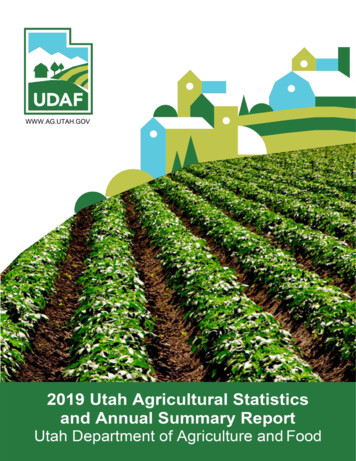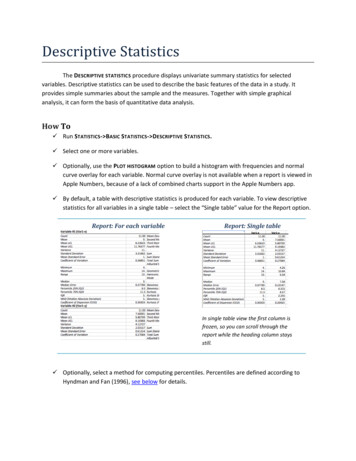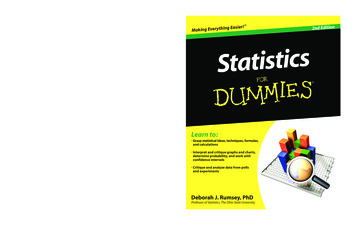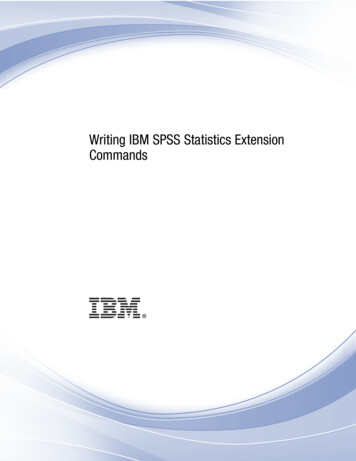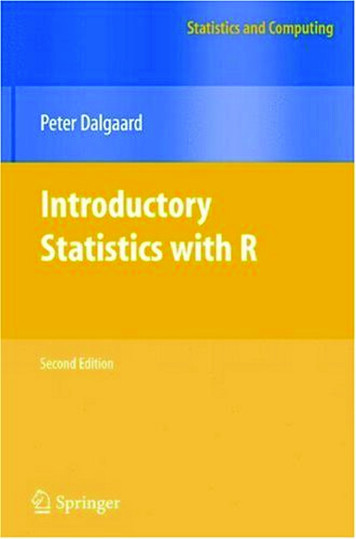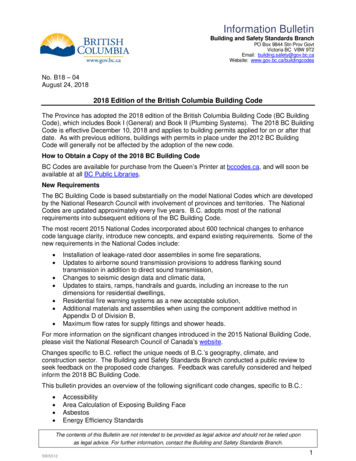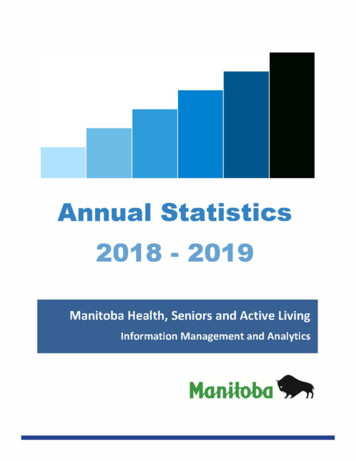
Transcription
Annual Statistics2018 - 2019Manitoba Health, Seniors and Active LivingInformation Management and Analytics
Manitoba Health, Seniors and Ac ve Living2Annual Sta s cs 2018-2019
Table of ContentsPreface5How to Use This Report6Important Notes and Data Cau ons7Addi onal Publica ons to Consider8Demographics9Map of Manitoba Regional Health Authori esPopulation PyramidsPregnancyBirthsDeathsDependency Ra oDependency Ra o10111213141516Popula on Health Status and Mortality17Disease and Injury21Premature MortalityInfant MortalityChild Mortality181920Hypertension (High Blood Pressure)DiabetesLower Limb Amputa ons among Residents withDiabetes Chronic Obstructive Pulmonary Disease(COPD)Acute Myocardial Infarction (Heart A ack)StrokeChronic ConditionsInjury Hospitaliza onInjury Mortality222324252627282930Cumula ve Mental IllnessMood and Anxiety DisordersPersonality DisordersSchizophreniaSubstance AbuseHospitaliza on for Self-Inflicted InjurySuicide32333435363738Mental Illness31Health Services Insurance Plan39Use of Medical Services41Insured Services per Capita40Number of General Practioners and SpecialistsNumber of Nurses and Nurse PractitionersPhysician Use - OverallManitoba Health, Seniors and Ac ve Living3424344Annual Sta s cs 2018-2019
Physician Use - Primary CarePhysician Use - Specialist CareMajority of CareAmbulatory Care Visits45464748Use of Hospital Services49High Profile Surgeries57Map of Hospitals by Facility SizeUse of HospitalsInpa ent Hospital Separa onsHospitaliza ons by Service TypeDay SurgeryHospitaliza on for Ambulatory Care Sensitive ConditionsAlternate Level of CareCoronary Artery Bypass Gra Surgery and PercutaneousCoronary Interven on SurgeryHip ReplacementKnee ReplacementCataract SurgeryPaediatric Dental ExtractionWomen’s Reproduc ve ean SectionVaginal Birth a er Caesarean Section646566Use of Home Care Services67Use of Personal Care Homes71Preventa ve Services77Total Home Care ClientsHome Care Admissions and Discharges6869Map of Personal Care Homes by Facility SizePersonal Care Home AdmissionsMedian Wait Times for Personal Care Home AdmissionMedian Length of Stay (Years) at Personal Care HomesBreast Cancer ScreeningCervical Cancer ScreeningInfluenza Immuniza onsPneumococcal Immuniza ons7273747578798081Prescrip on Drug Use83Glossary87Pharmaceutical UseDrugs Dispensed per UserTotal Drug Expenditures by Plan and RHAManitoba Health, Seniors and Ac ve Living8485864Annual Sta s cs 2018-2019
PrefaceManitoba Health, Seniors and Active Living’s Annual Statistics report is designed for a broad audiencethat includes health professionals, researchers, policymakers and the general public. This report describes Manitoba’s population, health utilization and health status using key health indicators measuredboth over time and for the most recently available fiscal or calendar year.Manitoba’s health care system is a broad network of services and programs. Overseeing this system isManitoba Health, Seniors and Active Living, a department of the provincial government. Primarily, services are delivered through the Service Delivery Organizations (SDOs) which include Shared Health,CancerCare Manitoba (CCMB), Addictions Foundation of Manitoba (AFM) and the five regional healthauthorities; Winnipeg RHA, Southern Health-Santé Sud, Interlake-Eastern RHA, Prairie Mountain Healthand Northern Health Region.In Manitoba, the SDOs are responsible, within the context of broad provincial policy direction, forassessing and prioritizing needs and health goals, and developing and managing health services in theirregion/mandate.Any inquiries pertaining to this publication generally or in reference to specific indicators should be addressed to:Information Management and Analytics BranchManitoba Health, Seniors and Active LivingRoom 4124300 Carlton StreetWinnipeg, Manitoba R3B 3M9Phone: 204-786-7229Karen HerdDeputy MinisterManitoba Health, Seniors and Ac ve LivingManitoba Health, Seniors and Ac ve Living5Annual Sta s cs 2018-2019
How to Use This ReportThe Manitoba Health, Seniors and Ac ve Living Annual Statis cs report is a descrip ve report comprised of 13 sections. The report looks at the distribu on of the popula on, mortality, disease andinjury, prevalence of mental illness, physician and hospital services, use of home care and personalcare homes, preventa ve services and prescrip on drug use. Unless otherwise stated, indicators inthis report are popula on-based rather than service-based. In other words, the indicators reflectwhere people live, not where they received services.For most indicators the report provides a rate by RHA and then a more in-depth look or “Highlight”at the Manitoba level. For some indicators, the data is only presented at the Manitoba level. Themajority of the indicators report data for the 2018/2019 fiscal year. Where most recent data wasnot available, the prior year was used. However, in some instances due to small numbers, multipleyears had to be combined to ensure confidentiality and to achieve stable rates. For more information on how the indicators were calculated and defined please refer to the glossary.Indicators found in this report show similar trends to indicators found in other public documents.However, exact rates in this report cannot be directly compared due to different inclusion andexclusion criteria.The report provides descrip ve analyses of indicators, not explanatory. Indicators are produced using administrative data, which does not include information on context, history or local circumstances. The information in this report should be used in conjunction with information from othersources so that regional and provincial planners, and decision-makers can make well-informeddecisions.Manitoba Health, Seniors and Ac ve Living6Annual Sta s cs 2018-2019
Important Notes and Data CautionsThroughout the report, the RHAs are shown in a par cular order based on their overall health status asmeasured by the premature mortality rate (PMR). PMR was calculated for the RHAs by the ManitobaCentre for Health Policy for the RHA Indicators Atlas 2019¹. A death before the age of 75 is consideredto be premature, Therefore the PMR is the average annual rate of deaths before the age of 75, per1,000 residents under 75. The RHA with the lowest PMR (best overall health status) appears at thetop of the graph. The RHA with the highest PMR (poorest overall health status) appears at the bottomof the graph.Two types of rates are presented in this report: crude rates and adjusted rates.Crude rates: A crude rate is the expression of the frequency of an event in a defined population in a definedperiod of time. It is calculated by dividing the number of observa ons by the suitablepopulation and multiplying by an appropriate mul plier (such as 100) to create a percentage.Although crude rates do not take differences in population structure into account, they are vitalfor policy and programming as they represent the actual rate in a given population.Adjusted Rates: The adjustment of rates is a statistical process that makes groups such as those in par culargeographic areas comparable by removing the effects of demographic differences such as ageand gender distribution. Essentially, adjusted rates tell us what the rates would be if eachgeographic area had the same age and sex distribution. Therefore, adjusted rates are fictional rates which use statistical models to remove the effects of age and sex differences toallow for comparisons across populations.Accordingly, while adjusted rates have been statistically modelled to be comparable to eachother, they should be considered fictional in the sense that they do not measure anythingdirectly. Please note that these adjusted rates cannot be compared to other rates that havenot received the same adjustment.Sta s cal Tes ng:Sta s cal tes ng was performed to determine whether regional rates were sta s cally significantly different from the Manitoba rate for each time period. If a difference was sta s cally different, then we are 99per cent confident that this difference is not just due to chance.Please note the following data cautions when reading the graphs:(*) Indicates that the region is sta s cally different from Manitoba.(!) Indicates that the regional rate should be used with caution due to small numbers.(-) Indicates that the regional rate is suppressed because the numerator contains a small number ofindividuals which could potentially be identified.(.) Indicates that there was no data for this time period.1¹ Fransoo R, Mahar A, The Need To Know Team, Anderson A, Prior H, Koseva I, McCulloch S, Jarmasz J,Burchill S. The 2019 RHA Indicators Atlas. Winnipeg, MB. Manitoba Centre for Health Policy. Autumn 2019.Manitoba Health, Seniors and Ac ve Living7Annual Sta s cs 2018-2019
Additional Publications to ConsiderWhile this report has a empted to provide an overview of sta s cs from across the health care system, itis by no means exhaus ve.For more detailed informa on on cancer incidence and mortality, please refer to the following link fromCancerCare y-cancer-registry/reportsThe regional health authorities also provide statis cs in the comprehensive Community Health Assessments that are conducted every five years. The reports for each of the RHAs can be found at:Interlake-Eastern RHAwww.ierha.ca/default.aspx?cid 23027&lang 1Northern Health s-and-publications/community-reports/Southern Health-Santé s-and-reports/community-health-assessmentPrairie Mountain Healthwww.pmh-mb.ca/cha-2019Winnipeg RHAwww.wrha.mb.ca/research/cha/Manitoba Health, Seniors and Ac ve Living8Annual Sta s cs 2018-2019
DemographicsThe following sec on provides an overview of the demographics of the popula on of Manitoba. This includespopulation distribution and size, pregnancies, births anddeaths.As of June 1, 2018, Manitoba had a population of 1,360,518residents, of which approximately 50 per cent were maleand 50 per cent female.There were a total of 19,216 pregnancies among Manitobafemales ages 15 to 49 in 2018/2019. There were 16,803 babies born in 2017/2018. In 2017/2018, 11,058 Manitobansdied, with the majority of these deaths being due to circulatory disease and cancer.Manitoba Health, Seniors and Ac ve Living9Annual Sta s cs 2018-2019
DEMOGRAPHICSMap of Manitoba Regional Health Authori esManitoba Health, Seniors and Ac ve Living10Annual Sta s cs 2018-2019
DEMOGRAPHICSPopula on PyramidsFigure 1: Population pyramid for Manitoba as of June 1, 2018For more informa on on Manitoba’s popula on, pleaserefer to the Manitoba Health, Seniors and Active Living’s Popula on Report at http://www.manitoba.ca/health/population/.Figure 1 shows the age and sex composi on of theManitoba population, based on records of residentsregistered with Manitoba Health, Seniors and ActiveLiving on June 1, 2018. The percentage of the population within each parcular age group is shown for malesand females. As of June 1, 2018, the total populationof Manitoba was 1,360,518 residents, of which approximately 50 per cent were male and approximately 50per cent were female. In the population pyramidabove two dis nct bulges can be seen. One representsthose in their fi ies, and the second represents thosein their twen es.Figure 2 shows the age and sex composi on of Manitoba First Na ons people based on records of self-reported First Nations residents registered withManitoba Health, Seniors and Active Living on June 1,2018. First Nations people in Manitoba are a muchyounger population. Of the 104,852 people whodeclared their First Nations status to Manitoba Health,Seniors and Active Living, approximately 53 per centwere under the age of 25, compared to approximately32 per cent for the Manitoba popula on overall.Manitoba Health, Seniors and Ac ve LivingFigure 2: Population pyramid for Manitoba First Na onspeople as of June 1, 201811Annual Sta s cs 2018-2019
DEMOGRAPHICSPregnancyFigure 3: Age-adjusted rate of pregnancies per 1,000 female residents ages 15 to 49 by RHA, 2018/2019Figure 3 shows the age-adjusted rate of pregnancies forManitoba women ages 15 to 49 by RHA of residence.Pregnancies include all documented live births, s llbirths, abortions and ectopic pregnancies.Northern Health Region had the highest age-adjustedpregnancy rate, which was 50 per cent higher than forManitoba overall.The majority of pregnancies in Manitoba were amongwomen ages 20 to 34, with 76.3 per cent of pregnanciesrepresented by women in this age group (Figure 4).In 2018/2019, there were a total of 19,216 pregnanciesamong Manitoba women ages 15 to 49, representing arate of 61.5 pregnancies per 1,000 women in the sameage group.Figure 4: Percentage of total pregnancies by age group, 2018/2019Manitoba Health, Seniors and Ac ve Living12Annual Sta s cs 2018-2019
DEMOGRAPHICSBirthsFigure 5: Crude rate of total births per 1,000 residents by RHA of residence, 2017/2018Figure 5 shows the crude number of live births by RHAof residence, per 1,000 population.In 2017/2018, there were 16,803 babies born to Manitoba residents, representing a rate of 12.4 newborns per1,000 population. Rates varied significantly across theprovince, ranging from a high of 21.1 births per 1,000 inNorthern Health Region to a low of 10.9 births per1,000 in Winnipeg RHA.The majority of babies born in Manitoba had a weightthat was appropriate-for-gesta onal-age with 79 percent of newborns within this group (Figure 6). Of theremaining newborns, 12 per cent were large-for-gestaonal-age and nine per cent were small-forgestational-age.Figure 6: Percentage of total live births by size for gesta onal age, 2017/2018Manitoba Health, Seniors and Ac ve Living13Annual Sta s cs 2018-2019
DEMOGRAPHICSDeathsFigure 7: Age-and sex-adjusted rate of death per 1,000 residents by RHA, 2017/2018Figure 7 shows the age-and sex-adjusted death rate per1,000 population by region of residence.In 2017/2018, 11,058 Manitoba residents died, representing a rate of 8.1 deaths per 1,000 population. Theage-and sex-adjusted death rate in Northern HealthRegion was significantly higher than Manitoba overall.In Manitoba overall, the five most common causesof death (excluding ill-defined causes) were:1) circulatory disease (23.4 per cent)2) cancer (22.8 per cent)3) mental/behavioural (7.4 per cent)4) respiratory disease (8.1 per cent)5) injuries (5.9 per cent)These five causes represented 67.6 per cent of alldeaths (Figure 8).Figure 8: Percentage of deaths by cause, 2017/2018Manitoba Health, Seniors and Ac ve Living14Annual Sta s cs 2018-2019
DEMOGRAPHICSDependency Ra oFigure 9: Youth 0-19 and seniors 65 and older as a per cent of population 20 to 64 years by RHA, 2018/2019Figure 9 shows the demographic dependency ra oby youth and seniors. According to Sta s cs Canada,seniors aged 65 or older and children and youth younger than 20 are likely to be socially and/or economicallydependent on working-age Manitobans, and may putadditional demands on health services. The demographic dependency ra o measures the size of the dependentpopula on in rela on to the working age popula on.Northern Health Region had the highest youth demographic dependency ra o with a youth-to-working-ageManitoba Health, Seniors and Ac ve Livingra o of approximately two-thirds (68.5 per cent),indicating that there will be an abundance of youthmoving into the working-age population in the future.When focusing on the senior popula on, Prairie Mountain Health had the highest senior demographic dependency ratio with a senior-to-working-age ratio ofapproximately one-third (33.1 per cent), indicating thatthis region might have a higher demand for healthservices for this age group.15Annual Sta s cs 2018-2019
DEMOGRAPHICSDependency Ra oFigure 10: Youth 0-19 and seniors 65 and older as a per cent of population 20 to 64 years, 2009/2010 to 2018/2019Monitoring youth and senior demographic dependency over me is important. A declining youth ra o mayrepresent an inadequate workforce available to supportre ree pensions in coming years, while an increasingsenior ra o may indicate a growing elderly popula onrequiring more health services from a propor onallysmaller workforce.Figure 10 shows that in Manitoba there has been aslight decline in the youth ratio from 44.3 per centManitoba Health, Seniors and Ac ve Livingin 2009/2010 to 42.3 per cent in 2018/2019, and theseniors ratio has increased slightly from 23.1 per cent in2009/2010 to 26.2 per cent in 2018/2019.For more informa on about the demographic ra o, clickon the following epeng.htm16Annual Sta s cs 2018-2019
PopulationHealth Statusand MortalityThe following sec on provides an overview of popula onhealth status and mortality within Manitoba. This includespremature mortality rates, infant mortality rates and childmortality rates.From 2013/2014 to 2017/2018, an average of 4,135Manitoba residents died each year before the age of 75.For the same time period there was an annual average ofabout 83 infant deaths, and 97 deaths of children betweenthe ages of one and 19. The rate of death for male childrenremained consistently higher than female children.Manitoba Health, Seniors and Ac ve Living17Annual Sta s cs 2018-2019
POPULATION HEALTH STATUS AND MORTALITYPremature MortalityFigure 11: Age-and sex-adjusted rate of premature death per 1,000 residents under the age of 75 by RHA, 2013/2014 to 2017/2018Figure 11 shows the age-and sex-adjusted prematuremortality rate (PMR). Premature mortality is defined asdeath before the age of 75. PMR is used as an indicatorof general health of a popula on; a higher PMR indicatespoorer health status.On average per year, there were 4,135 Manitoba residents that died before the age of 75, representing a rateof 3.3 deaths per 1,000 residents. The premature mortality rate in Northern Health Region was significantlyhigher than in Manitoba overall.In Manitoba overall, the five most common causesof premature death (excluding ill-defined causes)were (Figure 12):1) cancer (33.4 per cent)2) circulatory (20.9 per cent)3) injuries (12.3 per cent)4) respiratory (5.7 per cent)5) digestive (4.9 per cent)Figure 12: Percentage of premature deaths, by cause 2017/2018Manitoba Health, Seniors and Ac ve Living18Annual Sta s cs 2018-2019
POPULATION HEALTH STATUS AND MORTALITYInfant MortalityFigure 13: Crude rate of infant death per 1,000 live births by RHA, 2013/2014 to 2017/2018Figure 13 shows the crude rate of infant death by RHAof residence. Infants are defined as individuals less thanone year of age. Infant mortality is seen as an indicatorof health status, level of health care in area and effecveness of prenatal care.From 2013/2015 to 2017/2018, there were 416 deathsamong Manitoba infants, representing a rate of fivedeaths per 1,000 live births. The infant mortality ratein Northern Health Region was significantly higher thanManitoba overall.Figure 14 shows the infant mortality rate in Manitobaover time. The overall infant mortality rate in Manitobaappeared to decrease over time, with the mortalityrate in males being generally higher than that offemales. Due to a refinement in the defini on for this indicator,rates presented below may not match those from previous reports.Figure 14: Crude rate of infant death per 1,000 live births by fiscal yearManitoba Health, Seniors and Ac ve Living19Annual Sta s cs 2018-2019
POPULATION HEALTH STATUS AND MORTALITYChild MortalityFigure 15: Age-and sex-adjusted rate of death per 100,000 children age one to 19 by RHA, 2013/2014 to 2017/2018Figure 15 shows the age-and sex-adjusted rate of childdeath by RHA of residence. Children are defined as individuals between ages one and 19.than Manitoba overall, while the rate in Winnipeg RHAwas significantly lower.Figure 16 shows the child mortality rate in Manitoba overme. The child mortality rate in Manitoba appeared tobe increasing over me, with the mortality rate in malesremaining consistently higher than that of females.From 2013/2015 to 2017/2018, there were 483 deathsamong Manitoba children. This represented a rate of30.3 deaths per 100,000 children. The child mortalityrate in Northern Health Region was significantly higherFigure 16: Rate of death per 100,000 children age one to 19 by fiscal yearManitoba Health, Seniors and Ac ve Living20Annual Sta s cs 2018-2019
Disease and InjuryThe following sec on provides an overview of the burden of illnessfor selected diseases and chronic conditions, along with injury hospitalizations and deaths due to injury.In 2017/2018, 29.4 per cent of Manitobans age 20 and older hadhypertension, and 9.5 percent of Manitobans age one and olderhad diabetes.From 2014/2015 to 2018/2019, 1,079 Manitobans age 19 andolder with diabetes had a lower limb amputa on.The rate of chronic obstruc ve pulmonary disease (COPD)among Manitoba residents age 35 and older was 12.6 per cent in2017/2018.In the same time period, there were approximately three heart attacks and two strokes for every 1,000 Manitoba residents age 40and older.In 2017/2018, 55 per cent of Manitobans age 40 and older had oneor more of the following chronic condi ons: diabetes, hypertension, ischemic heart disease, heart failure, stroke or chronicobstruc ve pulmonary disease (COPD).For the same me period, there were 8,601 injury-relatedhospitalizations. In 2017/2018, there were 559 deaths whereinjury was the cause of death.Manitoba Health, Seniors and Ac ve Living21Annual Sta s cs 2018-2019
DISEASE AND INJURYHypertension (High Blood Pressure)Figure 17: Age-and sex-adjusted per cent of residents with hypertension age 20 and older by RHA, 2017/2018Figure 17 shows the age-and sex-adjusted prevalenceof hypertension among Manitoba residents age 20 andolder by RHA of residence.and the percentage of people living with hypertensionwas significantly higher in Northern Health Region whencompared to Manitoba overall.In 2017/2018, there were 298,373 Manitobans withhypertension (high blood pressure). This represented29.4 per cent of the total population age 20 and older.Hypertension prevalence varied across the province,Figure 18 shows hypertension prevalence in Manitobaover time by sex. Over the last ten years, females havehad a higher prevalence of hypertension than males. Thisgap has been closing over the last few years.Figure 18: Per cent of residents with hypertension age 20 and older by fiscal year and sexManitoba Health, Seniors and Ac ve Living22Annual Sta s cs 2018-2019
DISEASE AND INJURYDiabetesFigure 19: Age-and sex-adjusted per cent of residents with diabetes age one and older by RHA, 2017/2018Figure 19 shows the age-and sex-adjusted prevalence ofdiabetes among Manitoba residents age one and olderby RHA of residence.In 2017/2018, there were 127,330 Manitobans withdiabetes, representing 9.5 per cent of the total population age one and older. Diabetes prevalence variedacross the province ranging from a high of 20 per centin Northern Health Region to a low of 7.2 per cent inSouthern Health-Santé Sud.Figure 20 shows diabetes prevalence in Manitoba overme by sex. Over the last 10 years, males have had ahigher prevalence of diabetes than females. This gap hasbeen increasing over the last few years.Figure 20: Per cent of residents with diabetes age one and older by fiscal year and sexManitoba Health, Seniors and Ac ve Living23Annual Sta s cs 2018-2019
DISEASE AND INJURYLower Limb Amputa ons among Residents with DiabetesFigure 21: Age-and sex-adjusted rate of lower limb amputa ons per 1,000 residents with diabetes age 19 and older by RHA, 2014/2015to 2018/2019Figure 21 shows the age-and sex-adjusted prevalence oflower limb amputa ons among residents with diabetesage 19 and older by RHA of residence.From 2014/2015 to 2018/2019, there were 1,079 Manitobans with diabetes who had a lower limb amputaon, represen ng a rate of 10.5 amputa ons per 1,000residents age 19 and older with diabetes. Lower limbamputation incidence across the province ranged froma high of 18.3 per 1,000 in Northern Health Region to alow of 8.7 per 1,000 in Winnipeg RHA.Figure 22 shows the percentage of lower limb amputaons among Manitobans with diabetes, by age group.The largest percentage of amputations was in the 50to 69 age groups, represen ng 58.3 per cent of totalcases. Note that the rate is now presented per 1,000 ratherthan as per cent in previous reports.Figure 22: Percentage of lower limb amputa ons among residents with diabetes, by age group, 2014/2015 to 2018/2019Manitoba Health, Seniors and Ac ve Living24Annual Sta s cs 2018-2019
DISEASE AND INJURYChronic Obstruc ve Pulmonary Disease (COPD)Figure 23: Age–and sex-adjusted per cent of residents with chronic obstruc ve pulmonary disease age 35 and older by RHA, 2017/2018Figure 23 shows the age-and sex-adjusted rate of chronic obstruc ve pulmonary disease (COPD) in Manitoba forresidents age 35 and older by RHA of residence.In 2017/2018, there were 91,100 Manitoba residentswith COPD, representing a rate of 12.6 per cent of thepopulation age 35 and older. When compared to Manitoba overall, a higher rate of COPD was observed amongresidents of Northern Health Region and a lower rateamong residents of Southern Health-Santé Sud.Figure 24 shows the rate of chronic obstruc vepulmonary disease in Manitoba over time by sex.The rate of chronic obstruc ve pulmonary diseasehas remained stable for both males and femalessince 2008/2009.Figure 24: Per cent of residents with chronic obstructive pulmonary disease age 35 and older by fiscal year and sexManitoba Health, Seniors and Ac ve Living25Annual Sta s cs 2018-2019
DISEASE AND INJURYAcute Myocardial Infarc on (Heart A ack)Figure 25: Age-and sex-adjusted rate of heart attack per 1,000 residents age 40 and older by RHA, 2017/2018Figure 25 shows the age-and sex-adjusted rate ofheart a ack (AMI) in Manitoba residents age 40and older by RHA of residence.In 2017/2018, there were 2,063 heart attacks amongManitoba residents, representing a rate of 3.2 hearta acks per 1,000 population age 40 and older. Whencompared to Manitoba overall, a significantly higherrate of heart a acks occurred among Northernresidents.Figure 26 shows the rate of heart a acks in Manitobaover me by sex. The rate of heart a acks has consistently been higher for males compared to females. Therate for both genders has decreased over recent years.Figure 26: Rate of heart a ack per 1,000 residents age 40 and older by fiscal year and sexManitoba Health, Seniors and Ac ve Living26Annual Sta s cs 2018-2019
DISEASE AND INJURYStrokeFigure 27: Age-and sex-adjusted rate of stroke per 1,000 residents age 40 and older by RHA, 2017/2018Figure 27 shows the age-and sex-adjusted stroke rate inManitoba residents age 40 and older by RHA of residence.the province, with Winnipeg RHA ranging from a high of2.5 strokes per 1,000 residents to a low of 1.9 residentsin Prairie Mountain Health.In 2017/2018, there were 1,493 strokes among Manitoba residents, representing a rate of 2.3 strokes per1,000 population age 40 and older. Rates varied acrossFigure 28 shows the stroke rate in Manitoba residentsover me and sex. The rate of strokes for females andmales has been relatively stable over the last 10 yearsat between 2.3 and 2.8 per 1,000 population.Figure 28: Rate of stroke per 1,000 residents age 40 and older by fiscal year and sexManitoba Health, Seniors and Ac ve Living27Annual Sta s cs 2018-2019
DISEASE AND INJURYChronic Condi onsFigure 29: Age-and sex-adjusted per cent of residents with chronic conditions age 40 and older by RHA, 2017/2018Figure 29 shows the age-and sex-adjusted per cent ofpeople living with chronic condi ons. The chronic condion rate is defined as the per cent of the popula on age40 and older having one or more of the following conditions: diabetes, hypertension, ischemic heart disease,heart failure, stroke or chronic obstruc ve pulmonarydisease (COPD).In 2017/2018, 350,071 Manitobans age 40 and olderwere living with one or more chronic conditions, representing 55 per cent of the Manitoba population of thesame age group. The per cent of the popula on with atleast one chronic condi on ranged from 51.0 per cent inSouthern Health-Santé Sud to 66.9 per cent in NorthernHealth Region.Of those residents living with a chronic condi on,Figure 30 shows the propor on with one or multiplechronic conditions. Over one-half (51.0 per cent) ofthose with a chronic condition had just one condition,28.6 per cent had two conditions and the remaining20.4 per cent had three or more chronic conditions.Figure 30: Percentage of residents with chronic conditions age 40 and older by the number of chronic condi ons, 2017/2018Manitoba Health, Seniors and Ac ve Living28Annual Sta s cs 2018-2019
DISEASE AND INJURYInjury Hospitaliza onFigure 31: Age-and sex-adjusted rate of hospitalization for injury per 1,000 residents by RHA, 2018/2019Figure 31 shows the age-and sex-adjusted rate of injuryhospitalizations per 1,000 residents.In 2018/2019, there were 8,601 hospitalizations relatedto injury among Manitoba residents, representing a rateof 6.3 injury hospitaliza ons per 1,000 population.Rates varied significantly across the province. Residentsof Northern Health Region had more than two times therate of injury hospitaliza ons compared to Manitobaoverall, and the rate for Prairie Mountain Health wasalso significantly higher than the provincial average.Figure 32 shows the rate of injury hospitalization in2018/2019 among Manitobans by age and sex. Injuryhospitaliza ons steadily increased with age, specificallybeginning at age 15, for both males and females. Beginning at age 75, the rates for females are higher thanthat of males. Injury hospitaliza on rates for both sexesbegan to increase at the age of 70 and con nued toincrease exponen ally up to age 90 and older.Figure 32: Age-and sex
Manitoba Health, Seniors and Ac ve Living 5 Annual Sta s cs 2018-2019 Preface Manitoba Health, Seniors and Active Living's Annual Statistics report is designed for a broad audience that includes health professionals, researchers, policymakers and the general public. This report de-



